Ancient collective cooking remains and tombs discovered in Guanquehe Site, Qinghai Province
From:Chinese Archaeology NetWriter:Date:2015-08-26
In order to cooperate with the infrastructure, the salvage excavation of the ancient tombs and remains from Guanquehe Site in Reshui Town, Dulan County, Qinghai Province has been carried out jointly by Qinghai Provincial Institute of Cultural Relics and Archaeology and Shaan’xi Provincial Institute of Archaeology from April to September in 2014. 10 house foundations, 31 hearth pits, 25 tombs and 6 sacrificial pits are cleared, covering an area of 7695 square meters.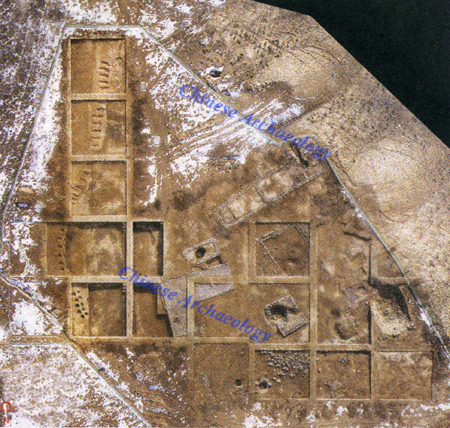
top view of Guanquehe site
Guanquehe Site is located on the first terrace of the left bank of Chahanwusu River in Qinghai Province. The collective cooking remains were found in the eastern part of the site. On the east side of the site, there were lines of hearth pits intensively distributed from the south to the north in arc plane on the gentle slope at the foot of Du hill. According to planes of the pits, they can be divided into two categories, pear-shaped ones and circular ones.
There are 30 pear-shaped heart pits all oriented from the east to the west. A whole hearth consists of two round earthen pits with flat bases which are connected with each other on the bottom. But on the ground they are separated. The pit in the west is used to place firewood, while the east is used as burning chamber. And the opening of the east pit is used as a kitchen range. A smoking flue is made of a breach on the east edge of the range. The smoking flue was higher than the burnt chamber which was higher than the opening of firewood in sequence. The kitchen ranges are about 1.2-2.1m long, and firewood opening have an about 0.5m diameter, 0.4m deep. The diameters of the ranges are slightly larger than those of the firewood openings, while their depths are more or less in the same size. The smoking flue is in the shape of inverted ‘U’, about 0.2m long and 0.15m wide. Burnt surfaces and red burnt earths were often seen in the burnt chamber and smoking flue. There was plenty of charcoal ash, charcoals, a few gray sand-tempered pottery shards as well as animal bones being found in the bottoms of the hearths.
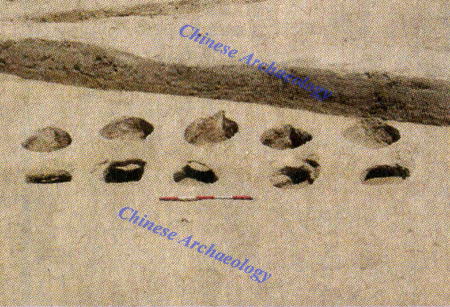
pear-shaped hearth
There is only one round hearth with a round base as a whole. The diameter of the opening is 0.74m and the depth residue is about 0.2m. 3 irregular and adobe-made support stands were found constructed on the slope of the bottom holding up the cookers. Besides, there are burnt surfaces on the support stands and upper part of the pit walls. There were charcoal ashes and a few animal bones discovered in the bottom, too.
Plenty of ashes were distributed in the western part of the hearth area in the shape of arch north-south oriented. The remains were probably activity floor in front of the hearth where plenty of charcoal ashes, charcoal and a few sand-tempered gray pottery shards found. Besides, there were lots of animal bones, mainly limb bones of cattle and sheep. Most of the bones were broken so that people could eat the marrows inside.
The middle-west part was living area of the site, where 7 house foundations were concentrated but oriented in different directions. Most of them were looted and left only stone-built wall bases and inner activity floors. According to structures of the house foundations, we can divide them into two groups, single-roomed buildings and multi-roomed buildings.
There were only 2 single-roomed buildings being found. They had only one room and simple structure. On the living surface of F3, there were broken pottery jars and scattered animal bones discovered. On the outside ground, there were ashes discarded by people’s daily life at that time, together with a few pottery shards and animal bones.
There were 5 multi-roomed buildings in a relatively large size. They always have several rooms of different functions. Their inner-structures are relatively complex. For example, F1 is square in plane, about 13.5m long and 13m wide. 5 small chambers are separated by stone walls and rammed earth walls. In the southwestern chamber, a hearth with three adobe-made support stands was discovered. On the living surface of the next room, there was ash trace and burnt stone deposits. Therefore, the southwestern part of the house is predicted to be a kitchen, while the rest of the building is for storage and daily life.
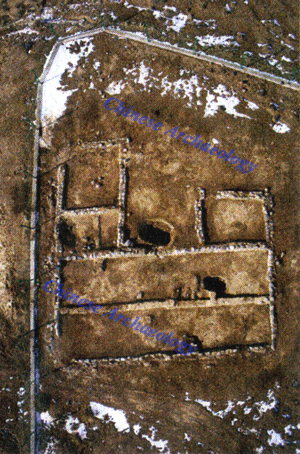
top view of multi-roomed building F1
25 tombs were cleared in this excavation, most of which were concentrated in the cemetery groups in the eastern part of Lusigou ditch which was on the south bank of Chahanwusu River. According to their form and structures, they could be divided into 4 categories, namely stone-chambered tomb, brick-chambered tomb, wooden outer coffin tomb and earthen pit tomb. In the cemetery, tombs of the same type were distributed together.
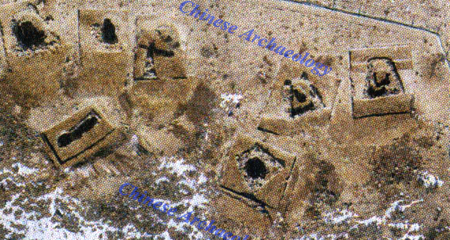
top view of small-scaled stone-chambered tombs
There was only 1 brick-chambered tomb with a long, sloping tomb passage, burial pit and burial chamber. The burial pit was a square earthen shaft pit and the burial chamber was nearly square in plane. There was wood plank made of 10 3.3m long timbers covered on the top of chamber, on which pebbles were paved.
3 wooden outer coffin tombs were discovered, which consisted of burial pit, timber plank and outer coffin chamber. The outer coffin chamber of M6 was built by square woods on which there were ancient Tibetan characters in ink about direction marks and counting
Besides, there were 3 earthen shaft pit tombs of different forms. They consisted of stone mound, burial pit and coffin bed. In the southern part of M20’s burial pit, there was an earthen coffin bed being found.
Although these tombs are of different forms, they are basically built in the same method. Their burial chambers were all constructed in a square earthen pit with a juniper or juniper branches made tomb ceiling and a mound. The funeral furniture and forms haven’t been identified since most of the tombs were looted.
6 sacrificial pits were evenly distributed in the nearby areas of the stone-chamber tombs which were relatively high rank tombs. According to the contents of the pits, they can be divided into horse pits and human and animal pits. As the highest rank of sacrificial pit, K2 is rectangular in plane, about 0.96m wide from south to north, about 12m long from east to west and more or less 1m deep residue. There were 9 horse skeletons being found in the bottom of the pit. All the foreheads of skulls had fractures probably caused by blunts when they are killed in the ritual practices. The horses in the pit were in different positions and directions, and were identified to be male adults when they were killed. There are only 5 old female horses sacrificed in a small-sized pit, K1. This might suggest that there are relatively special ritual practices and level differences in the local region at that time.
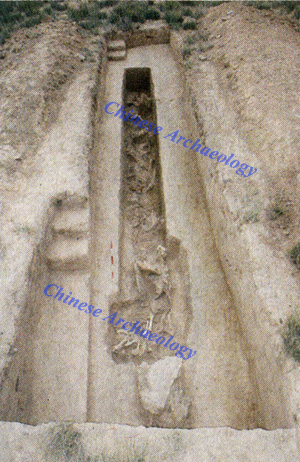
house burial K2
There were only a few numbers of funeral gifts being unearthed because that most of the tombs were looted. The burial goods contain pottery, bronze, stone-made decorations, animal bones which were used to practice divination, wooden slips, silks and feathers and so on. Some of the animal bones might have been drawn on human figurine in ink. Besides, there were also wooden slips written on ancient Tibetan characters being uncovered in ink.
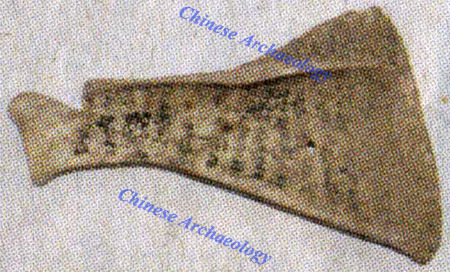
ancient Tibetan characters written in ink on animal bone

ancient Tibetan characters written in ink on wooden slips
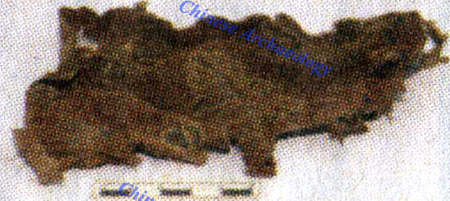
relic of silk
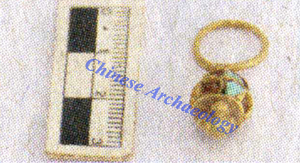
gold ear pendant

